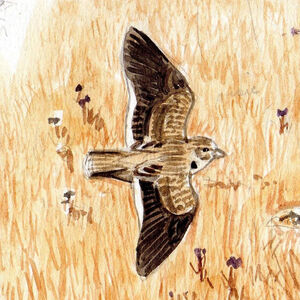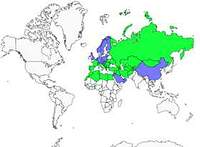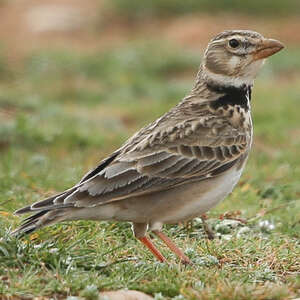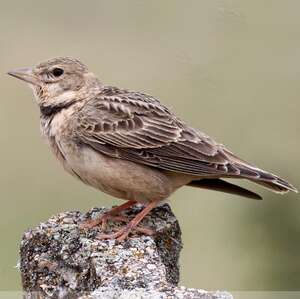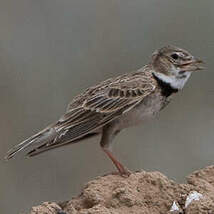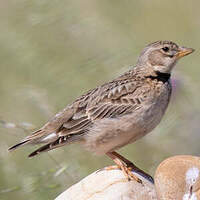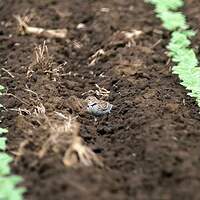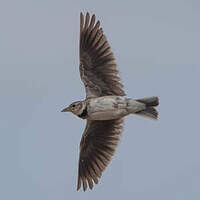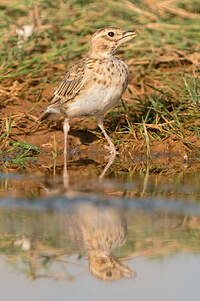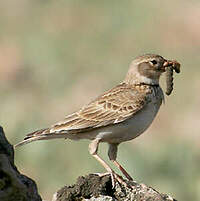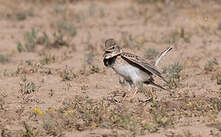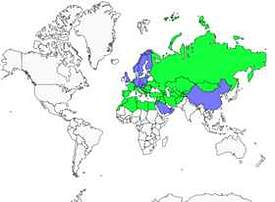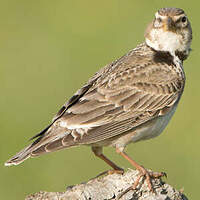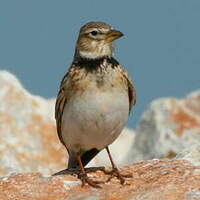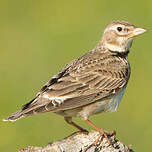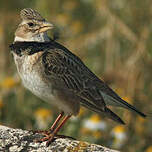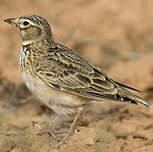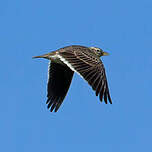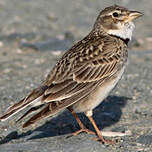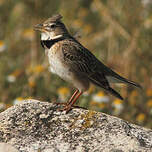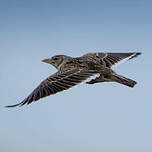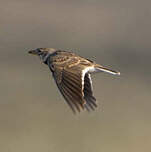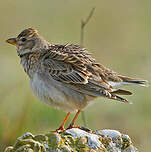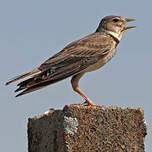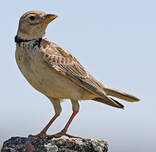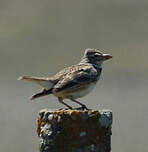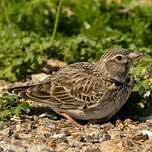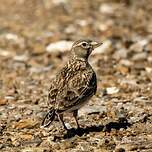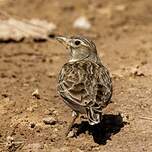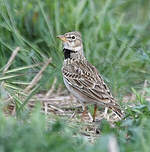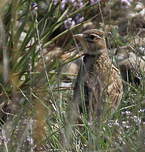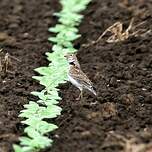Calandra Lark
Melanocorypha calandra - Alouette calandre
Identification
The Calandra Lark is a large, stocky lark with a relatively short tail. Its head is equipped with a large, distinctly curved culmen. The eye is widely framed with white, with a dark loral stripe in front and a clear eyebrow behind. The throat is white and the base of the neck has a distinct, black half-collar topped with white. The chest is ochre-colored and slightly speckled. The belly is light beige. The flanks of birds in the south of its range are warmer. The upper parts are of a medium-brown color with a dark brown bar on the mid-coverts.
Viewed from below in flight, it shows a very dark underside of the wing with a white posterior edge. The white lateral edges of the tail can also be seen, but less distinctly.
The legs are pinkish, with a hind claw the size of the finger.
The two sexes are practically identical. Only, the black spot on the neck is reduced in the female.
The juvenile can be distinguished by a very reduced, or even absent, black collar and upper coverts bordered with a pale edging.
Subspecific information 4 subspecies
- Melanocorypha calandra calandra (s Europe and nw Africa to Turkey. except sc and se. , Transcaucasia and nw Iran.)
- Melanocorypha calandra psammochroa (n Iraq and n Iran to Turkmenistan and Kazakhstan)
- Melanocorypha calandra gaza (e Syria and se Turkey to sw Iran)
- Melanocorypha calandra hebraica (sc Turkey and nw Syria to Israel and w Jordan)
Foreign names
- Alouette calandre,
- Calandria común,
- calhandra-real,
- Kalanderlerche,
- kalandrapacsirta,
- Kalanderleeuwerik,
- Calandra,
- kalanderlärka,
- Kalanderlerke,
- škovran stepný,
- kalandra zpěvná,
- Kalanderlærke,
- arokiuru,
- calàndria comuna,
- Sunnulævirki,
- kalandra szara,
- stepes cīrulis,
- laški škrjanec,
- Степной жаворонок,
- クロエリコウテンシ,
- 草原百灵,
- kalanderlärka,
- 草原百靈,
Voice song and call
The contact call of the Calandra Lark is short, rolling and nasal: tchrryup, klitrr. Its song is reminiscent of the Song Thrush but slower. It produces gurgling, high-pitched sounds at a rapid pace. It alternates flute-like and some gruffer tones. In spring, males are loud and sing loud. It is an excellent imitator of the song of other birds.
As with all larks, it sings mostly in flight but also while standing on the ground, which allows us to see its black and white swollen throat acting as a banner.
It is said of the Calandra Lark that it grisoles, turlutes or plays the barrel organ.
Habitat
Behaviour character trait
Flight
The singing flight of the Calandra Lark is very typical. It starts to sing from the ascending phase, then when it reaches a good height, it starts to glide in circles or stay almost still against the wind depending on its intensity. After flying over its territory for a few minutes, it descends to about 100 meters altitude before suddenly diving towards the ground.
Dietfeeding habits
The diet of the Calandra Lark is mixed. Mostly insectivorous in spring, it turns to plant material and seeds, particularly cereal seeds, in the bad season. It particularly likes hemp seeds. The insects sought are the large insects mostly among the Orthopterans, Coleopterans and Lepidopterans.
Reproduction nesting
Calandra Lark nests on the ground, usually under a plant or small bush, more rarely in a more open place.
It has a strong preference for cereal fields. It uses a small depression to build its nest. The nest is of rudimentary construction and is made of dry grass and straw, with a finer interior lining of grass strands. From mid-April it lays 4 or 5 greenish eggs spotted with brown. Incubation, which lasts 12 to 14 days, is undertaken by the female. The very vigorous chicks leave the nest after 11 or 12 days but will only fly from the twentieth when their plumage is complete.Geographic range
Threats - protection
IUCN conservation status
concern
in the Wild
threatened
evaluated
The species is in decline. It is likely that increasing treatments of agricultural surfaces with pesticides have contributed to contaminating many birds, including the Calandra Lark. This decline is primarily noted in France, Italy, Greece and Spain. The French population of the Calandra Lark has decreased significantly since the 1950s.
Sources of information
- IOC World Bird List (v14.2), Gill, F and D Donsker (Eds). 2024-04-18.
- Guide des oiseaux de France et d'Europe, Roger Tory Peterson, Guy Mountfort, P. A. D (Phill
- Le guide ornitho : Le guide le plus complet des oiseaux d'Europe, d'Afrique du Nord et du Moyen-Orient : 900 espèces, Svensson, Mullarney, Zetterstrom
- Les Oiseaux d'Europe, d'Afrique du Nord et du Moyen-Orient, Lars Jonsson
Other sources of interest
 Specification sheet created on
03/08/2023 by Jean-Pierre Trouillas
Specification sheet created on
03/08/2023 by Jean-Pierre TrouillasTranslation by AI Oiseaux.net
© 1996-2025 Oiseaux.net
- Accipitriformes
- Aegotheliformes
- Anseriformes
- Apodiformes
- Apterygiformes
- Bucerotiformes
- Caprimulgiformes
- Cariamiformes
- Casuariiformes
- Charadriiformes
- Ciconiiformes
- Coliiformes
- Columbiformes
- Coraciiformes
- Cuculiformes
- Eurypygiformes
- Falconiformes
- Galliformes
- Gaviiformes
- Gruiformes
- Leptosomiformes
- Mesitornithiformes
- Musophagiformes
- Nyctibiiformes
- Opisthocomiformes
- Otidiformes
- Passeriformes
- Pelecaniformes
- Phaethontiformes
- Phoenicopteriformes
- Piciformes
- Podargiformes
- Podicipediformes
- Procellariiformes
- Psittaciformes
- Pterocliformes
- Rheiformes
- Sphenisciformes
- Steatornithiformes
- Strigiformes
- Struthioniformes
- Suliformes
- Tinamiformes
- Trogoniformes

